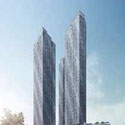Filter by
You must be a CTBUH Member to view this resource.
One Dubai Tower A
Building
Vision
1,008 m / 3,307 ft
201
Usually involved in the front end design, with a "typical" condition being that of a leadership role through either Schematic Design or Design Development, and then a monitoring role through the CD and CA phases.
The Design Engineer is usually involved in the front end design, typically taking the leadership role in the Schematic Design and Design Development, and then a monitoring role through the CD and CA phases.
The Design Engineer is usually involved in the front end design, typically taking the leadership role in the Schematic Design and Design Development, and then a monitoring role through the CD and CA phases.
You must be a CTBUH Member to view this resource.
Usually involved in the front end design, with a "typical" condition being that of a leadership role through either Schematic Design or Design Development, and then a monitoring role through the CD and CA phases.
The Design Engineer is usually involved in the front end design, typically taking the leadership role in the Schematic Design and Design Development, and then a monitoring role through the CD and CA phases.
The Design Engineer is usually involved in the front end design, typically taking the leadership role in the Schematic Design and Design Development, and then a monitoring role through the CD and CA phases.

16 March 2017 | Dubai
Thursday, March 16, 2017. Chicago, United States of America. Hosted in collaboration with the Chicago Architecture Foundation, the first lecture of the series Building Tall...

26 October 2015
Ahmad Abdelrazaq, Samsung C&T Corporation
Samsung and the authors’ involvement in these major tall and complex building projects have facilitated the transfer of the technologies and best practices to projects...

16 March 2017 | Dubai
Thursday, March 16, 2017. Chicago, United States of America. Hosted in collaboration with the Chicago Architecture Foundation, the first lecture of the series Building Tall...

19 September 2012 | Dubai
As tall buildings grow to greater heights and strive to incorporate more unique forms, clarity in the development of the structural system at conceptual design...

19 September 2012 | Dubai
This presentation presents the evolution of Mr. Smith’s career as a designer of supertall buildings, from Shanghai’s Jin Mao Tower, completed in 1999, to Kingdom...

03 November 2011 | Dubai
As one of the world’s foremost experts on supertall buildings, Adrian has contributed greatly to the development of this highly specialized building type. Adrian will...

26 October 2015
Ahmad Abdelrazaq, Samsung C&T Corporation
Samsung and the authors’ involvement in these major tall and complex building projects have facilitated the transfer of the technologies and best practices to projects...

21 September 2012
John Viise, Yantong Zhao & Robert Halvorson, Halvorson and Partners
As tall buildings grow to greater heights and strive to incorporate more unique forms, clarity in the development of the structural system at conceptual design...

19 September 2012
Adrian Smith, Adrian Smith + Gordon Gill Architecture
The paper traces the evolution of Mr. Smith’s career as a designer of supertall buildings, the Jin Mao Tower (1999) to Kingdom Tower, to be...
Subscribe below to receive periodic updates from CTBUH on the latest Tall Building and Urban news and CTBUH initiatives, including our monthly newsletter. Fields with a red asterisk (*) next to them are required.
View our privacy policy